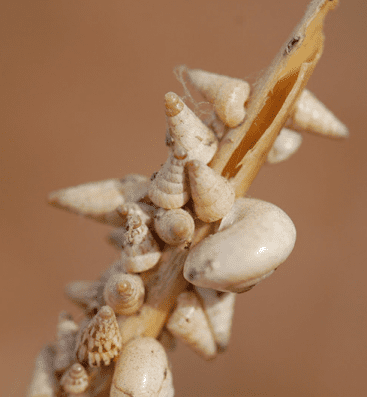SNAIL baiting trials in Western Australia in 2016 gave two key results: no single ingredient killed snails better than another, and bait density matters, according to Stirling to Coast Farmers (SCF) grower group research officer Dr Kathi McDonald.

There was no difference in the efficacy of rainfast baits compared with non-rainfast baits, but non-rainfast baits lost their integrity after 14 days.
“The amount of active ingredient per bait in the trials did not influence snail mortality, however, the more bait points there were, the more snails were killed by the baits,” Dr McDonald said.
Snails are a potential phytosanitary risk in grain shipments to important export markets such as China.
The snail research coincides with a grower survey that has confirmed small pointed conical snails are an increasing problem in the Albany and Esperance port zones, particularly in canola and barley crops.
The survey was conducted by SCF as part of a project initiated by the GRDC Albany port zone RCSN group. It was designed to help define the extent of the snail issue and identify current practices used in baiting control of snails and, to a lesser extent, slugs.
Dr McDonald said almost half the 120 growers who completed the survey indicated small pointed conical snails were present on their farms.
“Almost 60 per cent of growers with snails on their properties reported the pests were at levels requiring baiting,” she said.
“Most growers surveyed are just becoming aware of their snail problem, although some have recognised it as an issue for more than five years.
“Most growers with a snail issue apply baits at least once a year, usually after seeding with a spreader.
“However, there is a high level of uncertainty among growers as to the efficacy of baiting programs on small conical snail control.
“SCF members didn’t have a problem with snails in their grain this harvest but we aren’t being complacent about the issue. The group is working on strategies to reduce snail numbers such as effective early baiting and development of a snail roller to produce a clean grain sample.”
Caged bait trials
The trials in 2016 to measure baiting efficacy were ‘caged bait trials’, conducted by the Stirling to Coast Farmers (SCF) grower group in collaboration with the Department of Agriculture and Food (DAFWA), as part of a project initiated by the Grains Research and Development Corporation (GRDC) Albany port zone Regional Cropping Solutions Network (RCSN).
“There was no difference in the efficacy of rainfast baits compared with non-rainfast baits, but the trials suggested non-rainfast baits lost their integrity after 14 days.
“Iron-based and metaldehyde-based baits caused similar snail mortalities in the trials.
“There is more product choice in the metaldehyde range which includes products starting at about $4 per hectare.”
In 2017, SCF is conducting field trials which will further test the efficacy of best-bet baiting options in ‘real life’ paddock situations.
“Results so far suggest the field trials should use the highest registered rate of a bait that gives the most bait points per square metre – ideally at 48 bait points per square metre,” Dr McDonald said.
Cameras to model activity
In addition to the snail research led by SCF, DAFWA researcher Svetlana Micic is leading another GRDC investment in WA as part of a national project led by the South Australian Research and Development Institute (SARDI), aiming to increase knowledge of snail and slug species which cause damage.
The project will use cameras to monitor slug and snail movement, modelling when they are active to assist graingrowers to target their baiting to control the mollusc pests.
Source: GRDC.

HAVE YOUR SAY